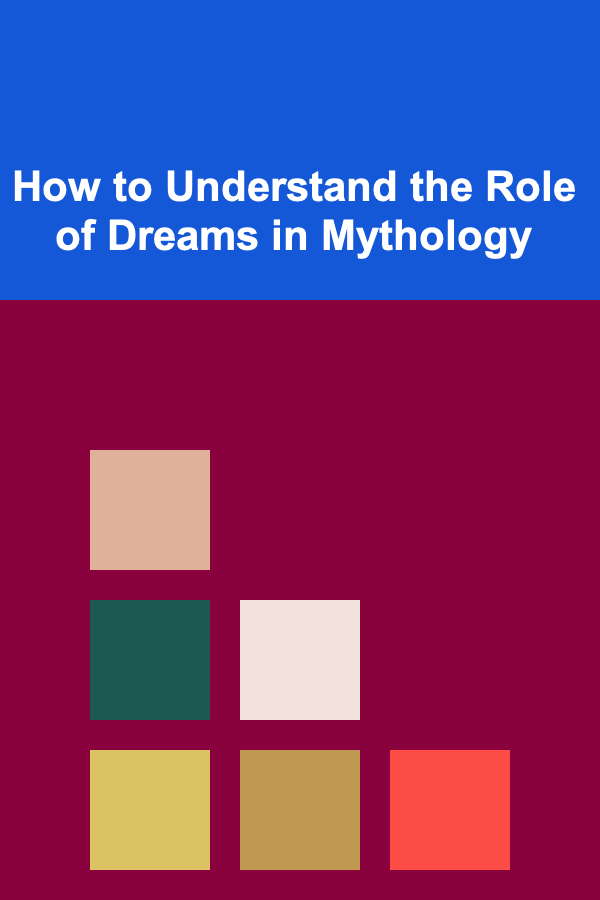
How to Understand the Role of Dreams in Mythology
ebook include PDF & Audio bundle (Micro Guide)
$12.99$8.99
Limited Time Offer! Order within the next:

Dreams have long been a fascinating subject of study and interpretation across cultures, and their relationship with mythology has been a central theme in various ancient civilizations. From the biblical visions of prophets to the dream sequences of Greek mythology, dreams have often been seen as messages from gods, portents of the future, or symbols of the subconscious mind. In this article, we will explore the complex and multifaceted role that dreams play in mythology, examining how they reflect cultural beliefs, personal transformation, and the interaction between the divine and the mortal.
The Universal Nature of Dreams
At their core, dreams are a universal human experience. Whether vivid or vague, joyful or nightmarish, dreams provide a window into our internal world and, at times, a connection to forces beyond our control. In mythology, dreams are often viewed not as random occurrences but as meaningful events---messages from the gods, symbols of psychological transformation, or even glimpses of otherworldly realms. Across cultures, dreams are given weight and significance, particularly in the context of mythology, where they can serve as the vehicle for a divine intervention or personal awakening.
What unites these diverse mythological traditions is the concept of dreams as a bridge between the conscious and unconscious, the mortal and divine, and the known and unknown. While modern psychology often seeks to explain dreams in terms of subconscious processes, ancient mythologies often attributed them to forces outside the individual, seeing them as tools of communication with gods, spirits, or even ancestors.
Dreams as Divine Messages in Ancient Mythologies
One of the most consistent roles that dreams play in mythology is that of a divine messenger. In ancient cultures, dreams were often interpreted as direct communication from deities, offering guidance, prophecy, or warnings. These dreams could be understood as a form of divine intervention in human affairs, shaping the fate of individuals, communities, or even entire civilizations.
Greek Mythology: Oracles and Prophetic Dreams
In Greek mythology, dreams were frequently portrayed as vehicles for divine communication. The ancient Greeks believed that gods and goddesses used dreams to communicate with mortals, often delivering prophecies or warnings about the future. For example, the famous Trojan prince Hector experienced a prophetic dream in which he was warned about the impending fall of Troy. Similarly, the great hero Achilles was often guided by dreams, one of which warned him about the futility of his own quest for glory.
Another prominent example from Greek mythology is the story of the Oracle of Delphi. The oracle, known as Pythia, was the priestess who delivered prophecies inspired by the god Apollo. While her prophecies were often spoken in a trance-like state, the ancient Greeks believed that many of these revelations came in dreams, highlighting the connection between dreams and the divine in Greek thought.
Egyptian Mythology: Dreams as Royal Symbols
In ancient Egyptian mythology, dreams were considered a powerful medium for communication with the gods, particularly in the context of the pharaohs. Pharaohs were believed to be divinely chosen rulers, and their dreams were interpreted as divine directives. The Pharaoh's dreams were thought to provide guidance on governance, military strategy, and even issues of personal morality.
One famous example from Egyptian mythology is the dream of Pharaoh Thutmose IV. According to legend, Thutmose IV had a dream in which the god Amun appeared to him and promised him the throne if he would free the Great Sphinx from the sands. This dream is considered a symbol of divine favor and is said to have played a key role in Thutmose IV's ascension to the throne.
Mesopotamian Mythology: Dreams and the Gods' Will
In the ancient civilizations of Mesopotamia, dreams were similarly seen as a medium for divine revelation. The gods, particularly the deities of the Sumerian and Akkadian pantheons, were believed to communicate their will through dreams. The Epic of Gilgamesh, one of the oldest known works of literature, offers an insightful look at the role of dreams in Mesopotamian mythology. In the epic, Gilgamesh experiences several dreams that are interpreted as omens of his destiny. These dreams are seen as premonitions of future events and are integral to the narrative structure of the epic.
The dream motif in Mesopotamian mythology also reflects a broader cultural belief that dreams were essential for understanding the will of the gods and the course of human destiny. Like the Greeks and Egyptians, the Mesopotamians regarded dreams as a bridge between the human and the divine, allowing mortals to access knowledge that would otherwise be hidden.
Dreams as Portents of Transformation
In many mythological traditions, dreams are not merely messages from the gods, but also serve as catalysts for personal transformation. The dreamer's experience within the dream realm can often parallel a larger journey of self-discovery, initiation, or metamorphosis. These transformative dreams help the individual navigate the challenges of life and death, providing a roadmap for their spiritual or psychological evolution.
The Hero's Journey: Dreams as Initiations
One of the most well-known frameworks for understanding personal transformation in mythology is the concept of the Hero's Journey, as described by Joseph Campbell in his influential work "The Hero with a Thousand Faces." In this structure, the hero undergoes a series of trials, challenges, and initiations, ultimately leading to their transformation and return to the ordinary world as a changed individual.
In many mythologies, dreams play a central role in this journey. They often serve as the "call to adventure," signaling the hero's transition from the familiar world to the unknown realm of transformation. For example, in the Norse myth of Odin, the god undergoes a mystical journey in which he sacrifices himself to gain wisdom. During this journey, Odin experiences vivid dreams and visions that guide him toward greater understanding and ultimate self-transcendence.
In other mythological traditions, dreams function as the "tests" or trials that the hero must overcome to reach the next stage of their journey. These dreams are often filled with symbolic imagery that represents the hero's deepest fears, desires, and moral dilemmas. By confronting these dreamscapes, the hero is able to unlock new levels of self-awareness, inner strength, and spiritual growth.
Shamanic Traditions: Dreams as Guides to the Spirit World
In shamanic mythologies, dreams are often regarded as portals to other realms, such as the spirit world, the underworld, or the world of ancestors. Shamans, or spiritual healers, use dreams as tools for divination, guidance, and healing. In many shamanic traditions, dreams are seen as a means of communication with the spirits, allowing the dreamer to receive wisdom, warnings, and healing energy from otherworldly sources.
For instance, in many Native American cultures, dreams are an essential part of spiritual practice. The Lakota people, for example, believe that dreams offer insight into one's personal path, providing guidance from ancestors and spirits. Similarly, in Siberian shamanism, the shaman's ability to navigate the spirit world is often gained through dreams and visionary experiences, which offer the shaman glimpses of hidden knowledge and transformative healing powers.
Dreams and Archetypes: Psychological Symbolism
While ancient mythologies often placed dreams within the context of divine or supernatural forces, modern interpretations of dreams have focused on their psychological and symbolic meaning. Carl Jung, the Swiss psychiatrist and psychoanalyst, famously developed the concept of archetypes, which are universal symbols and motifs that recur across cultures and mythologies.
In Jungian terms, dreams can be understood as expressions of the unconscious mind, revealing hidden aspects of the self. The figures and images encountered in dreams, such as monsters, gods, or mythic heroes, are seen as archetypal symbols that represent the various facets of the psyche. In this sense, dreams are not only messages from external forces, but also reflections of the inner workings of the mind and soul.
Jungian Interpretation of Mythological Dreams
Jungian analysis of mythological dreams focuses on how the archetypes present in dreams can lead to individuation, or the process of becoming one's true self. For instance, the archetype of the "shadow," representing the repressed or hidden aspects of the self, often appears in dreams as dark figures or threatening creatures. Confronting the shadow in the dream world is seen as a crucial step in psychological growth, allowing the dreamer to integrate these unconscious aspects of the psyche.
In the context of mythology, many heroes must face their own shadows in their dreams. These confrontations are often symbolic of the internal battles that individuals face as they undergo personal transformation. For example, the Greek hero Heracles must face a series of trials that mirror his own inner struggles with pride, guilt, and self-doubt. The dreamlike quality of these trials emphasizes the psychological aspect of the hero's journey.
Conclusion: Dreams as a Bridge Between Worlds
The role of dreams in mythology is both diverse and profound, encompassing themes of divine intervention, personal transformation, and psychological growth. Dreams serve as a powerful tool for understanding the human condition, bridging the gap between the conscious and unconscious, the mortal and divine, and the known and unknown. Whether as divine messages, prophecies, or transformative experiences, dreams have long been seen as a central element in mythological narratives, offering insights into the mysteries of life, death, and the human spirit.
As we continue to study the role of dreams in mythology, we gain a deeper understanding of how these ancient traditions reflect universal truths about the nature of existence, the struggle for meaning, and the quest for self-realization. Ultimately, the mythological representation of dreams reminds us that, in both ancient and modern contexts, dreams remain a vital and mysterious force---one that continues to guide, inspire, and transform us.

How to Clean and Sanitize Your Air Conditioning Unit
Read More
How to Know When It's Time to Sell Your Rental Property
Read More
How to Make Your Home Feel More Expensive with Lighting
Read More
How to Save Money on Home Improvement Projects
Read More
How to Set Competitive Rent Prices for Your Property
Read More
How to Set Up a Photo Booth for Memorable Moments
Read MoreOther Products

How to Clean and Sanitize Your Air Conditioning Unit
Read More
How to Know When It's Time to Sell Your Rental Property
Read More
How to Make Your Home Feel More Expensive with Lighting
Read More
How to Save Money on Home Improvement Projects
Read More
How to Set Competitive Rent Prices for Your Property
Read More